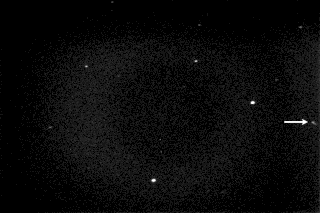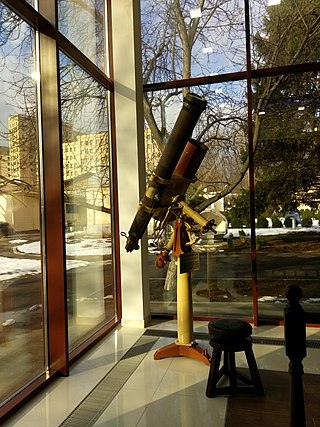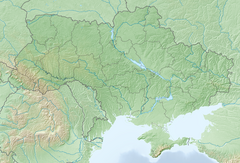
1620 Geographos is a highly elongated, stony asteroid, near-Earth object and potentially hazardous asteroid of the Apollo group, with a mean diameter of approximately 2.5 km (1.6 mi). It was discovered on 14 September 1951, by astronomers Albert George Wilson and Rudolph Minkowski at the Palomar Observatory in California, United States. The asteroid was named in honor of the National Geographic Society.
The Yarkovsky–O'Keefe–Radzievskii–Paddack effect, or YORP effect for short, changes the rotation state of a small astronomical body – that is, the body's spin rate and the obliquity of its pole(s) – due to the scattering of solar radiation off its surface and the emission of its own thermal radiation.

406 Erna, provisional designation 1895 CB, is a dark asteroid of the background population in the outer regions of the asteroid belt, approximately 46 kilometers in diameter. It was discovered by French astronomer Auguste Charlois at Nice Observatory on 22 August 1895. The asteroid was presumably named after Erna Bidschof, the granddaughter of Johann Palisa.
884 Priamus is a large Jupiter trojan from the Trojan camp, approximately 110 kilometers in diameter. It was discovered on 22 September 1917, by German astronomer Max Wolf at Heidelberg Observatory in southern Germany. The dark D-type asteroid is one of the 20 largest Jupiter trojans and has a rotation period of 6.9 hours. It was named after the Trojan king Priam from Greek mythology.
925 Alphonsina, provisional designation 1920 GM, is a stony Hansian asteroid from the central region of the asteroid belt, approximately 58 kilometers in diameter. It was discovered on 13 January 1920, by Catalan astronomer Josep Comas i Solà at the Fabra Observatory in Barcelona, Spain. The S-type asteroid has a rotation period of 7.88 hours. It was named for the Spanish Kings Alfonso X and Alfonso XIII.
1025 Riema, provisional designation 1923 NX, is a bright Hungaria asteroid from the innermost regions of the asteroid belt, approximately 5 kilometers in diameter. It was discovered on 12 August 1923, by German astronomer Karl Reinmuth at the Heidelberg Observatory in southwest Germany. The asteroid was named after ARI astronomer Johannes Riem.
1128 Astrid, provisional designation 1929 EB, is a carbonaceous Astridian asteroid from the central region of the asteroid belt. It is the parent body of the Astrid family and measures approximately 40 kilometers in diameter.
14335 Alexosipov, provisional designation 1981 RR3, is a stony Flora asteroid from the inner regions of the asteroid belt, approximately 4 kilometers in diameter. It was discovered by Soviet–Russian astronomer Nikolai Chernykh at the Crimean Astrophysical Observatory in Nauchnyj, on 3 September 1981. The asteroid was named after astronomer Alexandr Osipov.

1338 Duponta, provisional designation 1934 XA, is a stony Florian asteroid and synchronous binary system from the inner regions of the asteroid belt, approximately 7.8 kilometers in diameter.

1251 Hedera is a background asteroid from the central regions of the asteroid belt, approximately 13 kilometers in diameter. It was discovered on 25 January 1933, by German astronomer Karl Reinmuth at the Heidelberg-Königstuhl State Observatory in southwest Germany. The asteroid was named for the climbing plant Hedera, commonly known as "ivy".
5905 Johnson, provisional designation 1989 CJ1, is a Hungaria asteroid and synchronous binary system from the innermost regions of the asteroid belt, approximately 4 kilometers (2.5 miles) in diameter. It was discovered on 11 February 1989, by American astronomer Eleanor Helin at Palomar Observatory in California, United States. Its satellite measures approximately 1.6 km (1 mi) in diameter and orbits its primary every 21.8 hours. It was named after American astronomer and engineer Lindley N. Johnson.
3868 Mendoza, provisional designation 4575 P-L is a stony Vestian asteroid and binary system from the inner regions of the asteroid belt, approximately 9 kilometers in diameter. It was discovered on 24 September 1960, by astronomers Cornelis Johannes van Houten, Ingrid van Houten-Groeneveld and Tom Gehrels at Palomar Observatory.
1376 Michelle, provisional designation 1935 UH, is a stony Florian asteroid from the inner regions of the asteroid belt, approximately 8 kilometers in diameter. It was discovered on 29 October 1935, by French astronomer Guy Reiss at the North African Algiers Observatory in Algeria. It is named for the discoverer's daughter, Michelle Reiss.

1389 Onnie, provisional designation 1935 SS1, is a stony Koronian asteroid from the outer region of the asteroid belt, approximately 13 kilometers in diameter. It was discovered on 28 September 1935, by Dutch astronomer Hendrik van Gent at Leiden Southern Station, annex to the Johannesburg Observatory in South Africa.

1512 Oulu, provisional designation 1939 FE, is a dark Hildian asteroid, slow rotator and possibly the largest known tumbler orbiting in the outermost region of the asteroid belt. With a diameter of approximately 80 kilometers, it belongs to the fifty largest asteroids in the outer main-belt. The body was discovered on 18 March 1939, by Finnish astronomer Heikki Alikoski at Turku Observatory in Southwest Finland and named for the Finnish town Oulu.
2044 Wirt, provisional designation 1950 VE, is a binary Phocaea asteroid and Mars-crosser, approximately 6.7 kilometers in diameter. The minor-planet moon has an estimated diameter of 1.89 kilometer.

Ayyub Salah oghlu Guliyev is an Azerbaijani astronomer, researcher in the field of comets and small bodies. He is a doctor of physical and mathematical sciences, professor, corresponding member of Azerbaijan National Academy of Sciences (ANAS) and a former director of the Shamakhy Astrophysical Observatory. He is member of the International Astronomical Union and European Astronomical Society.

(162058) 1997 AE12 is a stony, sub-kilometer asteroid and likely the slowest rotator known to exist. It is classified as near-Earth object of the Amor group and measures approximately 800 meters in diameter. The asteroid was discovered on 10 January 1997 by the Spacewatch survey at Kitt Peak National Observatory near Tucson, Arizona

Institute of Astronomy of Kharkiv National University, or Kharkiv Astronomical Observatory — is a scientific institution at Kharkiv University. The institution was founded in 1808 as the astronomy laboratory of the university, and in 1888, mainly due to the efforts of Gregory Levitsky, a fully equipped observatory in a separate house was created.

Astronomical Observatory of Kazan University is a Russian astronomical observatory located in the city of Kazan at an altitude of 75 meters above sea level. It exists on the basis of the Department of Astronomy of Kazan University, founded in 1810 by Joseph Johann von Littrow. Object of cultural heritage of Russia of federal significance. On September 19, 2023, the observatory was inscribed on the UNESCO World Heritage List.















